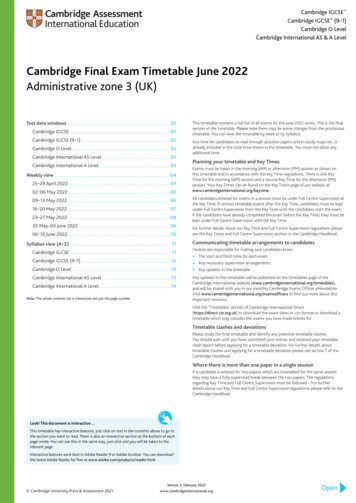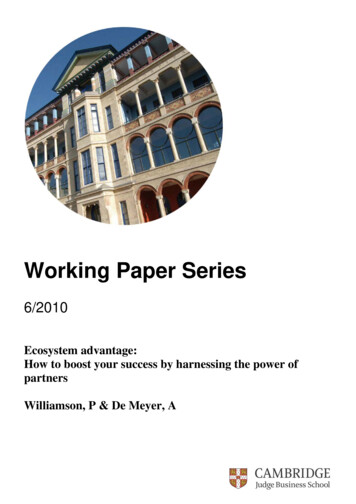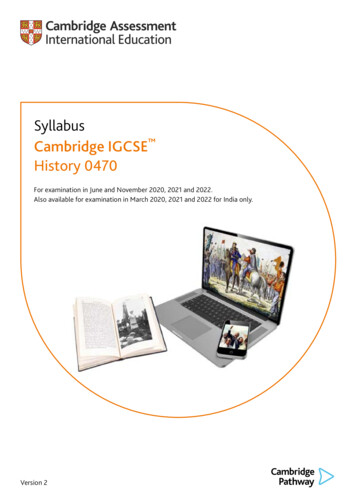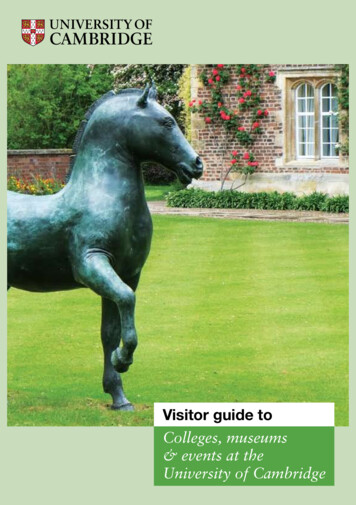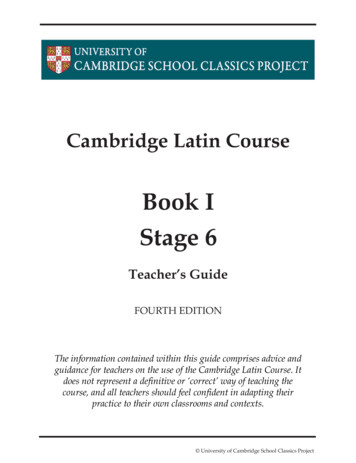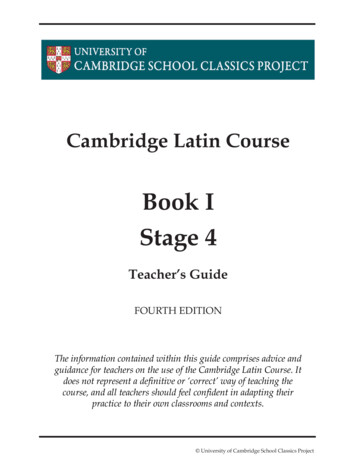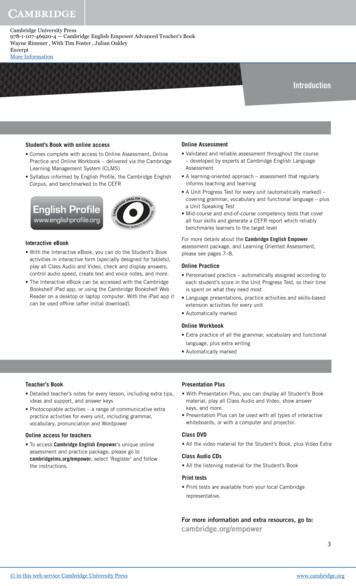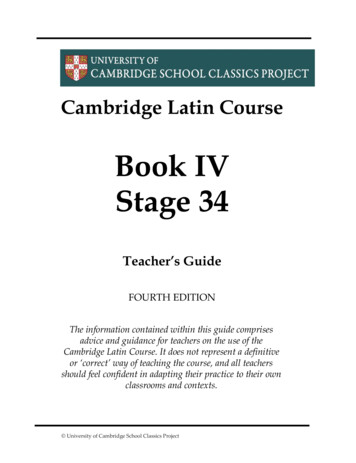
Transcription
Cambridge Latin CourseBook IVStage 34Teacher’s GuideFOURTH EDITIONThe information contained within this guide comprisesadvice and guidance for teachers on the use of theCambridge Latin Course. It does not represent a definitiveor ‘correct’ way of teaching the course, and all teachersshould feel confident in adapting their practice to their ownclassrooms and contexts. University of Cambridge School Classics Project
Faculty of Education,184 Hills Road,CambridgeCB2 8PQThis book, an outcome of work jointly commissioned by the Schools Councilbefore its closure and the Cambridge School Classics Project and is publishedwith the kind permission of the Department for Education. University of Cambridge School Classics ProjectIn the case of this publication the CSCP is waiving normal copyrightprovisions in that copies of this material may be made free of charge andwithout specific permission so long as they are for educational and notcommercial use. Any material that is used should be attributed to the CSCPclearly and prominently.First published 1973Second edition 1985Third edition 2003This edition 2020Produced for digital publication via www.cambridgescp.comThe CSCP has no responsibility for the persistence or accuracy of URLs forexternal or third-party internet websites referred to in this publication, anddoes not guarantee that any content on such websites is, or will remain,accurate or appropriate. Information regarding prices, travel timetables andother factual information given in this work is correct atthe time of publication.ACKNOWLEDGEMENTSFor help in preparing Book IV of the Cambridge Latin Course and the 4th Edition Teacher’s Guide we shouldlike to express our thanks to the following: Jill Dalladay for her extensive revision of the Guide; members ofthe Project’s Working Party: Eileen Emmett, Jean Hubbard and Pam Perkins; Robin Griffin, revision editor ofthe 2nd edition, for his expert advice and many stimulating suggestions for teaching method; Maire Collinsfor typing and formatting the text; and for assistance of various kinds: Patricia Acres, Simon Armour, RogerDavies, Lynda Goss, William Horbury, Debbie James, John Patterson, Tony Smith and Meg Thorpe. BobLister, who was the Director at that time, Pat Story, as Revision Editor, and Roger Dalladay, Picture Editor University of Cambridge School Classics Project
STAGE 34 lībertusCulturalBackgroundStory lineMain languagefeaturesFocus of exercisesFreedmanEpaphroditus bribesSalvius to exact revengeon Domitia and Paris. Bya trick, they are caughttogether in Haterius’empty house by thePraetorian Guard. Intrying to escape, Parisfalls to his death.Domitia is arrestedlamenting over his body. 1.2. Present passiveinfinitive.Future passive.Word PatternsCompound verbswith ad-, con-, prō-,trāns- and per-.3.Future active.Selection of correctLatin words totranslate anEnglish sentence.Perfect andpluperfect passive.Opening page (p. 93)Illustration. Start by asking students to study this page and tell you who they thinkwill play an important role in this Stage. Having established that it is Epaphroditusand that he is also the lībertus of the title, ask what they remember about him fromthe previous Stage (see also p. 74).Can they identify the kneeling figure wearing the conical cap? Some may rememberfrom a relief in Book I, Stage 6 (p. 69), that he represents a newly freed slave,expressing his gratitude and sense of obligation to his ex-master. (The relief isreproduced in this Stage, p. 106.)This illustration makes the point that freedmen like Epaphroditus might gainpositions of considerable power but they owed them to their ex-masters, to whomthey still had obligations. See the discussion section below.Before embarking on the first story read the brief biography of Epaphroditus onp. 95 and explain the meaning of the inscription. University of Cambridge School Classics Project
ultiō Epaphrodītī (p. 94)Story. With the approval of the emperor, Epaphroditus seeks revenge on Paris andDomitia. Finding it impossible to act openly, he bribes Salvius to set a trap for them.New language feature. The future passive, 3rd person singular and plural.First reading. Read lines 1-7 in Latin and elicit the meaning with comprehensionquestions, e.g.:What did Epaphroditus want to do, and why (lines 1-2)?What did the emperor urge Epaphroditus to do, and why (lines 2-4)?What was so difficult about this order for Epaphroditus (lines 4-6)?What did he do about it (lines 6-7)?Read the rest of the passage dramatically and ask students to translate it in pairs,raising any queries with you. Such is the momentum of the story, and the familiarityof the 3rd person passive endings, that students usually translate the new futurepassive verbs without difficulty.Discussion1 Epaphroditus. Why was he so powerful? Note: The power he wields as afreedman may seem surprising, but several imperial freedmen gainedpositions of influence at court because of their closeness to the emperor.Linked to the emperor by gratitude and loyalty, they personally dependedon him and were often regarded as more reliable and trustworthy thanpowerful senators who might be in control of an army and be potentialrivals. Their power increased under Claudius and his successors when theywere given important official positions, dealing for example, with petitions(like Epaphroditus) or judicial enquiries.2 Salvius. Is Salvius’ relationship with Epaphroditus better evidence of hiscloseness to the emperor than his statements on p. 30, where he tells Hateriushe had consulted the emperor about his reward, and in Book III p. 97, where hedeclares he is better placed than Agricola to know the emperor’s wishes aboutCogidubnus?3 When Salvius says ēmovēbitur, what does he really mean? This would be a goodopportunity to discuss English euphemisms, e.g. ‘taken out’, ‘taken care of’. University of Cambridge School Classics Project
ConsolidationAsk students in pairs to read dramatically the conversation between Epaphroditusand Salvius (lines 8-19).Set them to find all examples of ego and tū and tabulate them on the board. Canthey complete the tables? Do they remember the plurals? What do mēcum, tēcum,etc. mean? Refer to p. 120, if necessary.Draw attention to the active infinitives, difficile erat accūsāre (lines 4-6); pūnīrecupit (line 9), in preparation for the introduction of the present passive infinitive inthe next story. Revise the infinitive forms of the four conjugations.Illustration. Part of an honorary inscription to Epaphroditus (Museo NazionaleRomano, Rome), referring to the fact that Epaphroditus had honours granted him forhis part in exposing the conspiracy of Piso under Nero. It reads:(A) VG . L . EPAPHRODIT(O . APPARITORI . CAE)SARVM . VIATORI .TRIBVNIC(IO . HASTIS . P)VRIS . CORONIS . AVREIS . DONA(TO)To Augustus’ freedman Epaphroditus, attendant of the Caesars, assistant to the tribunes. presented with pure spears and golden crowns.Epaphroditus was a common slave name and there were several imperial freedmenof that name. This inscription, however, was found in the area of the gardens ownedby ‘our’ Epaphroditus, on the Esquiline, and therefore is more likely to refer to himthan to someone else (Inscriptiones Latinae Selectae 9505).Note that Augustī lībertus can refer to a freedman of any emperor. hastae pūraewere headless spears, which, like corōnae aureae, were given for valour in war.No doubt these honours were bitterly resented by Epaphroditus’ enemies.īnsidiae I (pp. 96-7)Story. Receiving a letter from Vitellia to say that she is ill, Domitia sets out on a foulnight to visit her friend. The unoccupied house, brilliantly lit, with a banquet spread,leaves Domitia puzzled and her slave girl alarmed.First reading. This is a useful passage for practice in independent work, and youcould take students’ answers in for marking. Explain that you will read lines 1-11through in Latin at least twice. Between your readings they should study questions University of Cambridge School Classics Project
1-6, which in themselves help understanding by focussing attention on particularsentences. Remind them that the form of the questions, and the marks allotted, giveclues to what is expected in their answers. Questions 7-15 are more testing. Withbright students repeat the same method as you used for the first half of the story,but with a slower class discussion in class should precede the request for writtenanswers.Discussion1 Domitia’s behaviour. How would you describe Domitia’s response to her friend’sletter? What did she find at the house that might have put her on her guard? Howwould you describe her behaviour: was she brave, or did she feel invulnerableas empress, or was she relying on the slaves outside the door, or was she tooconcerned about her friend to be afraid?2 Salvius’ plot. Where do you think he has gained his knowledge of Domitia’scharacter and likely behaviour? Do you think his wife would have helped him tomake use of her sister’s house? What can you remember about her (last seen inStage 14 entertaining Quintus, having removed the best furniture from Salvius’study in Britain to adorn the bedroom of the visitor)?3 Atmosphere. How would you describe the atmosphere of this passage? Identifythe words which create this effect. Does the title contribute to the effect? WhatEnglish title would you give to the story? If you were filming or recording thisstory, what sound effects would you use?4 Roman house. Put up a plan of a town house or ask students to sketch one (seeBook I, p. 11) so that they can envisage the events in the stories on pp. 96-9.ConsolidationSet individual students or pairs to prepare about five lines each to translate. Makesure the whole story is covered. Discuss their translations in story order.Ask students to pick out the nouns or pronouns described by the followingparticiples, and explain the cases used: missam (line 3), ēgressa (line 6), vecta (line9), apertam (line 12), ingredientibus (line 14), vīsīs (line 20). Discuss literal andidiomatic translations of the last two. University of Cambridge School Classics Project
īnsidiae II (pp. 97-8)Story. Vitellia’s bedroom is dark and Domitia sends her maid for a lamp. Whenshe does not return and the bedroom is found empty, Domitia is panic-stricken.Encountering Paris as she runs through the atrium, she realises a trap has been setfor them; they must escape while they can.First reading. Read the story at one sitting, but use a variety of techniques to addto students’ suspense and appreciation. For instance, handle lines 1-9 in a mannerwhich conveys the mounting tension leading up to Domitia’s realisation of the plotin falsa erat epistula!1 Read in Latin itaque ferret (lines 1-4), leaving Domitia in the dark while youask the class to tell you what has happened.2 Then read in silentiō nōn rediit (lines 4-6). By stopping here you emphasiseDomitia’s total isolation in the dark house. Ask volunteers to translate. Give creditfor the translation which best conveys the atmosphere.3 tandem vacuum erat (lines 6-7). Contrast Domitia’s impetuosity with thesudden threat presented by the word vacuum. Students will be eager to say whathas happened. Check that they understand morae impatiēns.4 In reading tum dēmum epistula (lines 7-9), build up the sense of mountingdanger and the horrifying realisation contained in the last words. Elicit themeaning with questions.5 After reading the remainder of the story, let students work out the meaning inpairs. Some may need help with priusquam accideret (line 11) andīnsidiae parātae sunt (line 15).Discussion1 The empress sets out with a team of litter bearers and her maid. Ask students toidentify the stages by which she becomes increasingly isolated: servīs relictīs (Part I, line 13), Chionēn remīsit (Part II, line 4), vacuum erat (Part II,line 7).2 What do you think is the climax of the story?3 dum redīret (line 5). This is the first occurrence of dum with the subjunctive.Students are quite likely to say ‘She waited until the slave-girl returned’. Do notcomment, but let them go on to the next sentence “But she did not return’) andthen invite amendments to the original sentence. ‘What was she waiting for?’ willhelp if students have difficulty. Point out the contrast between the indicative,used for facts, and the subjunctive often used for ‘not-quite-facts’, and then go University of Cambridge School Classics Project
on to explain the subjunctive in priusquam accideret (line 11). A previousexample of priusquam with the subjunctive occurred in Tychicus, p. 79, line 9,and there are further examples of dum and priusquam on p. 139.ConsolidationStudents might enjoy telling this story as Domitia, reproducing what she did andfelt in the empty house. Others (if there is time) might like to present the scene withcreepy musical and other sound effects at appropriate moments.** exitium I (p. 98)Story. Myropnous warns Paris and Domitia of the Praetorian Guard’s approach.While they flee to the back gate, he blocks the front door with furniture and, settingfire to it, turns to follow them.First reading. Keep a good pace by reading the story through in Latin and elicitingthe meaning by comprehension questions as you go, without formal translation. Thisis especially helpful with the more complex sentences: Domitia contendit (lines1-2); quō factō coepit (lines 11-13).Discussion1 Who were the Praetorian Guard? Does it surprise you that Epaphroditus was ableto command the emperor’s bodyguard?2 What effect is achieved by breaking the sentences into short phrases? Whatfeatures of language create this effect (e.g. ablative absolutes, participial phrases,neque reiterated, etc.)?3 Do you expect Domitia, Paris and Myropnous to escape?Note: ‘About the language I’ follows well here. See p. 77 of this Guide for teachingsuggestions.Consolidation. Check that students recognise the form and meaning of imperatives:prohibē (line 8) and prohibitions: nōlī dēspērāre (line 7) and give further practice ifnecessary.Pick out the examples of present participles: dīcente (line 1), haesitantēs (line 15),pulsantium (line 17), flagrante (line 19) and ask students for idiomatic translationsin context, together with the case, number and gender. University of Cambridge School Classics Project
exitium II (pp. 98-9)Story. Finding two soldiers guarding the back gate, Paris entices them inside sothat Domitia can escape. Trapped in the garden, he makes for the roof but loses hisfooting. Hearing him crash, Domitia returns and is arrested lamenting over his deadbody.First reading. Recall the events of exitium I by putting up some short key sentencesand asking for translation and comment. Take exitium II in three parts, reading eachsection aloud in Latin and exploring it with comprehension questions, some with theclass as a whole, some with students working in pairs or groups:Escape attempt, lines 1-12:What discovery did Paris and Domitia make at the back gate (lines 1-2)?How did Domitia react to this (lines 2-3)? How did Paris behave (lines 3-4)?Why did Paris dart out before dashing back into the garden (lines 4-6)?What did the soldiers shout?How did he baffle the soldiers? Why did he mock them (lines 9-10)?Fate of Paris, lines 13-22:What noise did Paris hear (lines 13-14)?What made him realise the extent of his danger (line 15)?Where did Paris leap from? Where to? Would you expect Paris to have a goodchance of making the leap? (lines 18-20)What went wrong (lines 21-2)?Fate of Domitia, lines 23-31.What had Domitia done while Paris was distracting the soldiers? Why had shenot run away? (lines 23-4)Why did she return to the garden (lines 24-7)?What caused her to give herself away (lines 27-9)?How did the tribune complete his mission (lines 30-1)?Discussion1 Why was Paris so popular? How would you describe his character? Can youthink of anyone comparable in the modern world of entertainment?2 What will probably happen to Domitia? Can students remember details ofSalvius’ promise to Epaphroditus (p. 94, line 16)?3 Note: Domitian’s suspicions about Paris and Domitia, Paris’ death in AD 83, anda divorce between Domitian and Domitia are recorded by the historiansSuetonius and Dio Cassius. The details in this Stage are fictitious. Subsequently, University of Cambridge School Classics Project
after the divorce, Domitian took his niece Julia as his mistress. Domitia wasrestored in AD 84, and both she and Julia lived with him. When Domitian wasmurdered in AD 96, Domitia may have known about the plot to kill him.ConsolidationDivide students into groups of three or four, and allocate to each group one sectionof the story to translate and explore, listing some features of language to find andexplain, e.g.:Lines 1-12: superlative adjective, verb in the subjunctive, ablative absolute.Lines 13-22: present participle, verb in subjunctive, deponent verb.Lines 23-31: deponent verb, verb in the subjunctive, ablative absolute.Ask the groups to share their work, and clear up any difficulties. Then focus onthe longer sentences (lines 2-4, 4-6, 23-4, 26-7, 27-8), asking comprehension questionssimilar to those on p. 140, which provide an opportunity for further practice. Somesentences lend themselves to the type of analysis suggested on p. 16 of this Guide.Illustration. Paris is posing behind the statue in order to hide from the PraetorianGuard. Ask students to pick out the Latin sentence that best describes the picture.About the language 1: present passive infinitive (p. 100)New language feature. The present passive infinitive, and the present infinitive ofdeponent verbs.Discussion. Read paragraphs 1-3 with the class, and set them to translate theexamples in paragraph 4. In going over their work, ask ‘What seems to be the usualdifference between the present active infinitive and the present passive infinitive?’.If necessary, draw attention to the 3rd conjugation by asking them which passiveinfinitive differs from the other three.Introduce paragraph 5 by asking students to translate a familiar sentence, e.g.:difficile est eīs per viās prōgredī (p. 96, line 10)Domitia ad aulam regredī cōnstituit (p. 97, line 10)After completing paragraph 5, ask students to demonstrate from the examples howthe deponent infinitive is like a passive infinitive (‘it ends in -ī’), and then how it islike an active infinitive (‘it means ‘to ‘, not ‘to be -ed’). University of Cambridge School Classics Project
ConsolidationAsk students to identify and translate in context the five passive and deponentinfinitives on p. 98, exitium I: vidērī (line 4), ingredī (line 9), ēlābī (line 10), effringī(line 16), sequī (line 19). Make sure that students can recognise deponent verbs in theVocabulary by studying p. 142, paragraphs 3-5.honōrēs (p. 101)Story. Congratulating Salvius, Epaphroditus describes Domitia’s fate, the plansfor public celebrations, and the emperor’s promise to give Salvius a consulship.Overhearing this, Myropnous realises Salvius’ part in Paris’ death and breaks hispipes, swearing not to play again until Salvius is dead.Note: Myropnous is an example of a character with a disability who doesn’tallow this to stop him from being a major player in the machinations of theRoman court. He provides an opportunity to discuss our attitudes towards thosewho are marginalised or considered “different”.First reading. Introduce the story by picking out with the class and putting on the boardall the promises that were made by Epaphroditus and Salvius in ultiō Epaphrodītī (p. 94):praemium tibi dabitur (line 10).ego tibi tōtam rem administrābō (line 12).īnsidiae parābuntur; Domitia et Paris ēlicientur; ambō capientur et pūnientur(lines 13-14).Domitia accūsābitur; damnābitur; fortasse relēgābitur (line 16).(Paris) ēmovēbitur (line 19).Ask students to cross off the promises which they know have so far been fulfilled.Read lines 1-19 of honōrēs in Latin and ask students what they have understoodfrom your reading. Then set them to translate the passage in pairs and find out if thelist of promises has now been completely fulfilled. Be prepared to help them withthe initial dative in line 1, and see how well they cope with the change of tenses inEpaphroditus’ speech.The mood of lines 20-6 is quite different. Explore it with comprehension questionsand then work out with the group the most powerful translation of the first and lastsentences, noting in particular the word order of lines 20-1. University of Cambridge School Classics Project
Discussion1 Why do you think there were to be public celebrations?2 What reward did Epaphroditus expect? What privileges would he gain by this(see p. 109)? Would it make him popular with noble-born senators?3 What reward was Salvius promised? Who told him? Is there anything odd in this?(Salvius held the consulship some time before AD 86.)4 What do you think is the likelihood of Myropnous being able to take vengeanceon Salvius?5 Do you think the title for this Stage is appropriate?ConsolidationAsk for an oral translation of lines 7-9 (puerī offerent), making sure that studentsrecognise the future active. Then to do exercise 1 in ‘Practising the language’.Ask for a written translation of Epaphroditus’ speech as an introduction tocompleting ‘About the language 2’.Illustration. Late 2nd century tombstone in Florence. The figure is shown withdouble pipes. The inscription in Greek reads:THEOIS KTo the gods and MYROPNOUI NANOMyropnous dwarfCHORAULEplayer for a chorus of singers and dancersAbout the language 2: future passive tense (p. 102)New language feature. Future passive, 3rd person singular and plural.Discussion. This is a straightforward note which also offers the opportunity toreinforce the characteristics of deponent verbs. Take it in two parts, paragraphs 1-3and 4 with consolidation after each part.Consolidation. After completing paragraphs 1-3, turn back to p. 94 and set studentsto identify verbs in the future tense in lines 7-19 and say whether they are active orpassive. Similarly, after paragraph 4, ask students to pick out the future tenses onp.101, lines 1-19, and say whether they are active, passive or deponent. University of Cambridge School Classics Project
Word patterns: compound verbs 3 (p. 103)New language feature. Compounds with the prefix ad-, con-, prō-, trāns- and per-.Discussion. Let students work through this independently or in groups and sharetheir observations.Practising the language (pp. 104-5)Exercise 1. Complete the sentences by selecting the correct person of the future active.Exercise 2. Translate English sentences into Latin with words chosen from a selection.Exercise 3. Translate active sentences and convert to passive form.IllustrationsThe consular symbols, drawings based on Roman coins. The fasces, a bundle ofrods tied with a red thong, was carried before a senior magistrate by a lictor. Aconsul had twelve lictors. The axe in each bundle was carried only outside Rome.The folding ivory sella cūrūlis was the chair of office on which a seniormagistrate sat when conducting official business.Small bronze statuette of a wreathed lictor holding the fasces (British Museum).Cultural background material (pp. 106-9)Content. This section extends the information about freedmen (including themanumission ceremony) given in Book I, Stage 6, and incorporates some tombinscriptions and a section on imperial freedmen.Discussion. The following questions could be used for clarification or discussion, oras a guide for students to make their own notes:1. How would you define a freedman?2. Why might a master choose to free a slave? (see also Stage 6: financial reasons,slave too old or infirm to work, slave freed at master’s death, slave could buyfreedom, freedom given as the result of a special act like saving the master’slife, etc.)3. What privileges were open to a Roman freedman?4. What constraints limited a Roman freedman?5. What were the obligations of (a) the ex-master (b) the ex-slave to each other?6. What led to some freedmen (usually not those who had been unskilled University of Cambridge School Classics Project
workers) becoming wealthy and successful?7. Why did some freedmen prefer to stay with their masters?8. What was special about lībertī Augustī? What powers and privileges didthey have? How were they viewed by Roman senators?The inscriptions on p. 108 are as follows:1 In memory of Titus Flavius Homerus, a well-deserving ex-master, Titus FlaviusHyacinthus (erected this tomb).2 In memory of Julius Vitalis, a well-deserving freedman, his ex-master (erected thistomb).3 Titus Flavius Eumolpus and Flavia Quinta built (this tomb) for themselves, theirfreedmen and freedwomen and their descendants.4 Titus Flavius Cerialis erected (this tomb) in memory of Flavia Philaenis his welldeserving freedwoman and wife.Illustrationsp. 106 Relief (Musée Royale du Mariemont). A magistrate is touching the kneelingslave with a rod. A slave already freed (left) is shaking hands with a fourthperson, probably his master. The kneeling figure is a slave bowing to hismaster after receiving his freedom. Both slaves are wearing the pilleus,showing that they have been freed.p. 107Hall of the Augustales. The shrine in the recess on the right would haveheld a statue, and there are two statue bases at the foot of the pillars, allfor statues of members of the imperial family, used as a focus for worship.The wall paintings feature Hercules, legendary founder of Herculaneum.Evidence for ceremonial dinners is found in inscriptions.Inscription from a tomb outside the Nuceria Gate, Pompeii, put up byPublius Vesonius, freedman, during his lifetime for himself and hispatroness, wife of his former master. The photograph shows the left-handcolumn, and part of the central column, of three columns. It reads:P VESONIVS ) L(IBERTVS)VESONIAEPHILEROS [AVGVSTALIS]PATRONAEVIVOS MONVMENT(VM)FECIT SIBI ET [SVIS]P(ublius) Vesonius Phileros, Caius’ freedman, [Augustalis], while still alive University of Cambridge School Classics Project
made this monument for himself and [his family] and his patroness Vesonia.The letter before L (line 1) is an alternative form of C. VIVOS is analternative form of VIVVS. The words in square brackets were obviouslysquashed in later, suggesting that Vesonius became an Augustalis andgained his own household after the inscription was completed.p. 109Courtyard in the private quarters of Domitian’s palace, surrounded bytwo- storey buildings. For the location of the palace see pp. 1 and 43.p. 110Obverse of aureus of Domitian (private collection). Inscription:IMP(ERATOR) CAES(AR) DOMIT(IANVS) AVG(VSTVS) GERM(ANICVS)P(ONTIFEX) M(AXIMVS) TR(IBVNICIA) P(OTESTAS) VI , meaning:Emperor Caesar Domitianus Augustus Germanicus, High Priest, holder ofTribunician Power six times.p. 111Reverse of bronze sestertius, showing Domitia and her infant son, wholater died (British Museum). Inscription: MATRI DIVI CAESAR(IS)S(ENATVS) C(ONSVLTO), meaning To the mother of the divine Caesar by thesenate’s command (note that senātus is a 4th declension noun).Checklist vocabulary: cognates and compoundsauctōritās, gaudēre, mors, precēs, suspiciō.Suggested activities1 Devise a funerary monument for Clemens, set up by his ex-master Quintus, withan inscription based on the formulae used in those on p. 108.2 Prepare for Test 2. Suggestions for students:a From each Stage in the book choose one story to re-read carefully, asking forhelp with any sentences or phrases you find difficult;b Read through the model sentences, and the ‘About the language’sections; select some of the examples to translate and ask for help withany difficulties;c Look over any work you have done on the cultural background, notingcarefully the comments and advice you have received. University of Cambridge School Classics Project
Cambridge Latin Course Book IV Stage 34 Teacher's Guide FOURTH EDITION The information contained within this guide comprises advice and guidance for teachers on the use of the Cambridge Latin Course. It does not represent a definitive or 'correct' way of teaching the course, and all teachers

